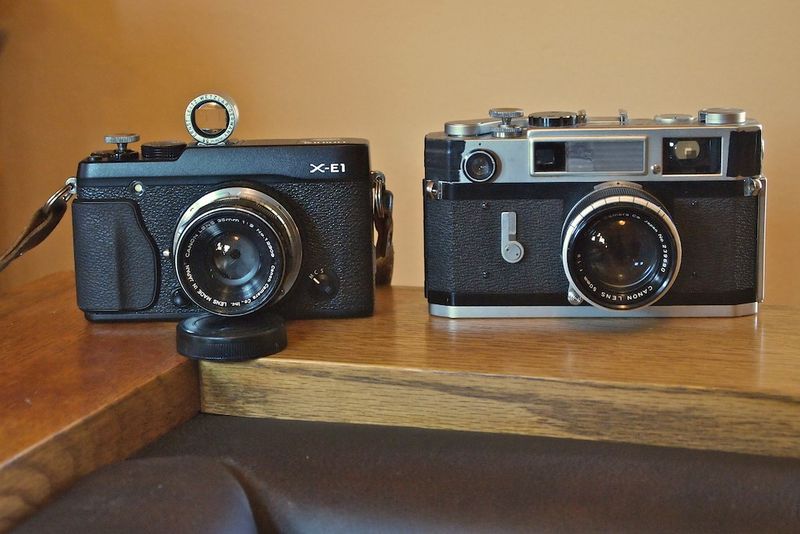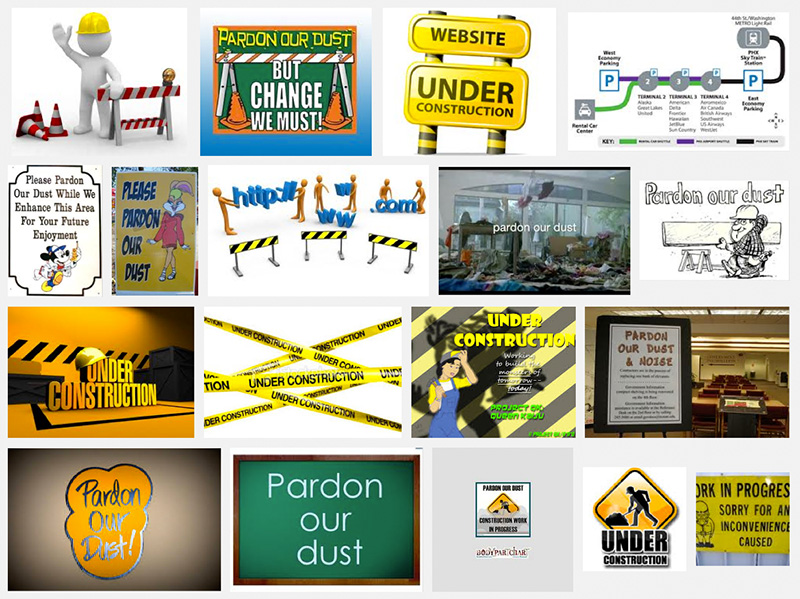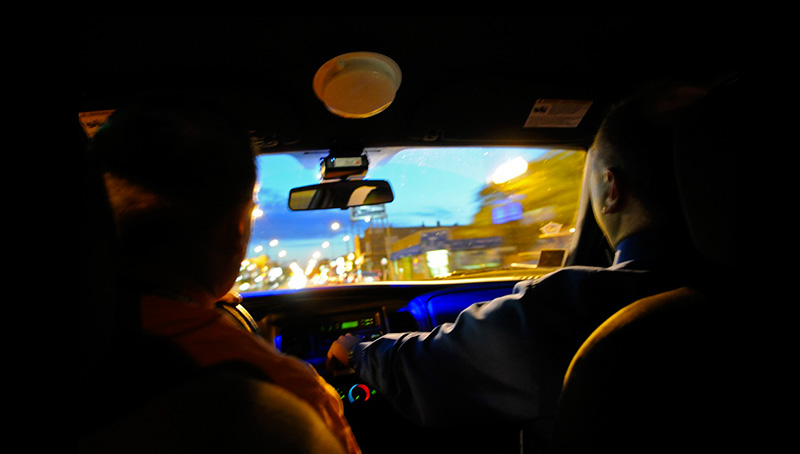 On the left, my new Fuji X-E1 with an old Canon 35mm RF lens (my new
"normal") mounted via a Fotodiox adapter. On the right, my nearly
50-year old—and clearly indestructible—Canon 7s rangefinder film
camera with a 50mm ƒ/1.8 lens, my old "normal," mounted via Canon's
Leica thread mount. Note the soft releases screwed into the shutter
buttons and the antique Leitz 50mm accessory bright-frame viewfinder now
used with the Fuji, which allows me to compose on the normal with both
eyes open.
On the left, my new Fuji X-E1 with an old Canon 35mm RF lens (my new
"normal") mounted via a Fotodiox adapter. On the right, my nearly
50-year old—and clearly indestructible—Canon 7s rangefinder film
camera with a 50mm ƒ/1.8 lens, my old "normal," mounted via Canon's
Leica thread mount. Note the soft releases screwed into the shutter
buttons and the antique Leitz 50mm accessory bright-frame viewfinder now
used with the Fuji, which allows me to compose on the normal with both
eyes open.
By Jim Hughes
Not too long ago, maybe three years at the most, my wife and I were bussing our own table at our favorite breakfast restaurant in Camden village when an acquaintance, a local filmmaker of some note who teaches a volunteer course at the high school, walked by, spied my 35mm rangefinder camera on the table next to the empty plates, and asked, a little incredulously, "Do you still shoot film? That looks suspiciously like an old Leica."
I explained that as long as my stock of Kodachrome held out and Dwayne's, the one K-14 lab left in the country, remained willing to process it, I would continue to shoot film. But no, I told him, the camera wasn't a Leica, but it was an old rangefinder 35. What he was looking at, I informed him, was a 1967 Canon 7s, the feel of which I actually preferred to the high-priced brand. I had purchased that Canon, with an editorial discount, for not much more than $100, directly from Bell & Howell in Chicago, the Japanese manufacturer's distributor back in the day.
The filmmaker, a bearded fellow in heavy canvas motorcycle pants, was accompanied by a young man, probably one of his students, who seemed intrigued. "May I see it?" he asked politely. Sure, I replied. I picked it up and handed it to him. Whereupon my prized possession promptly slipped through his fingers and bounced off my foot, which I had reflexively stuck out, and onto the hard tile floor with a thunk. I don't think he expected the heft of brass and steel in this age of plastic composites. I winced, picked the camera up, examined the base upon which it had landed, saw no dents or dings, advanced the film with a flick of the Canon's butter-smooth lever, focused the lens through the bright rangefinder window and fired off a couple quick exposures. Everything still worked, as it had unfailingly for nearly half a century.
"No damage that I can find," I announced, "except to my big toe. This camera and its lenses were engineered like little tanks and built to last." And they're a joy to use, I might have added if I'd been in a better mood. Despite its fall, and countless previous unprovoked encounters with doorways and numbskulls, the Canon had always kept going like the Energizer Bunny, along with my even older and just as reliable Kodak Retina IIa, a folder that I often carried clammed-up in a coat pocket until needed.
But the next year Kodachrome died, soon to be followed by the inevitable cessation of its processing. I tried substituting Fuji Velvia. I found it good for some subject matter, not so good for others. Eventually, I gave up the fight and bought my first digital camera, an Olympus E-PL1, whose multitude of buttons, menus and submenus gave me fits, and whose otherwise pleasantly retro Pen-like appearance suffered massively from the huge hump of its accessory eye-level electronic viewfinder that this left-eyed photographer absolutely required. Worse, it kept falling off. Worse yet, like most smaller digital cameras, its shutter button was not threaded for a cable release—meaning I could no longer use the soft-release mushroom extenders I had equipped almost all my cameras with for many decades, allowing me to handhold at the ridiculously slow shutter speeds Kodachrome often dictated. Still, the Olympus sensor and JPEG engine combined to give me a lot of well-rendered images, and its mirrorless Micro 4/3 design allowed me to use, in manual mode, most of my old Leica Thread Mount (LTM) Canon rangefinder lenses, glass that I had come to dearly love over the years, and whose characteristics were, and are, a good match for my particular way of seeing pictures. (As Ken Tanaka once wryly noted, "Wherever I go, there I am.")
Then one day during a snowstorm the Olympus' own lack of heft did it in. Its nylon strap slipped off my shoulder without my sensing it while I was crossing a street. The camera fell to the asphalt and landed on its backside. I tested it after brushing off a mess of slush, and everything seemed to work fine; but a couple nights later when I wanted to download the SD card and opened the door to its compartment, the adjacent battery just jumped right out onto my lap. The tiny plastic tab that is supposed to hold it in place had been shattered by the fall. So now every time I wanted to download a card, out would pop the battery like a little self-propelled rocket. When I realized that the out-of-warranty and probably already discontinued camera would have to be returned for service, and I would doubtless receive a refurbished model in its place, requiring me to go through the painful setup process all over again, I decided to just live with this and any future problems; it was time to relegate the Olympus to part-time status as a light-duty backup, and buy my second brand new camera in as many years.
After much research, I decided on the Fuji X-E1, second in that venerable company's X-trans APS-C interchangeable-lens line. Both look like real cameras, with shutter and aperture dials where they should be; both offer threaded shutter releases, and both have the same unusual random-pattern 16.3-MP sensor in 3:2 format (an important consideration for this 35mm no-crop shooter, who hated 4:3). I had at first considered the even costlier X-Pro1, but I thought the double-duty viewfinder (optical frames/electronic focusing) would prove too finicky for my purposes. Additionally, the Pro requires supplementary diopters to be attached to the eye-level viewfinder. The E1, on the other hand, has a fine-adjustment wheel built in, which allows me an exact match to the +.4 my left eye requires (for those who are wondering, my right eye needs no correction...it just doesn't visualize pictures the way my left eye does). Since the X-E1's excellent EVF provides a 100% view, and I've always liked frame lines that allow me to isolate a "picture" inside a shifting broader scene, at least with a "normal" focal length, I realized I could just slide the accessory finder, shown above, which I already had, into the camera's hot shoe.
I purchased the X-E1 in March, during Fuji's heavily discounted lens sale that in effect made the system, if not inexpensive, at least more affordable. [Ed. Note: Fuji's lens sale has just returned, as of midnight last night. Go to B&H Photo, look up any of the Fuji X cameras, then click on "Savings Available."] I went with the 18–55mm (27–84mm-e) ƒ/2.8–4 zoom, the kind of all-purpose lens I hadn't used since I traded my original Pen F many years ago, plus the normal 35mm (53mm-e) ƒ/1.4. If Fuji had offered an ƒ/2 35mm equivalent (as on its fixed-lens X cameras), I would have bought that as well. As it is, I am waiting for the much anticipated 23mm (35mm-e) ƒ/1.4 and/or the 27mm ƒ/2.8 (41mm-e) pancake. My two most used full-frame focal lengths for 35mm film cameras have always been 35mm and 50mm, and at my age I'm not about to change in that respect. And I've found the Fuji lenses I have been using for the past several weeks to be fine. Better than fine, actually, in terms of sharpness, tonality and color rendition, at least when teamed with the X-E1's sensor. My only problem is relative size. Relative, of course, to what I've been used to. Not that they are heavy (the Canons, in fact, are heavier). The Fuji lenses are just bulkier.




